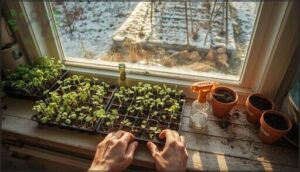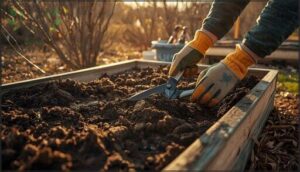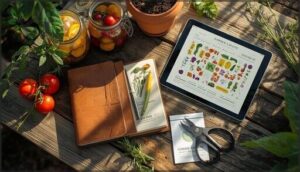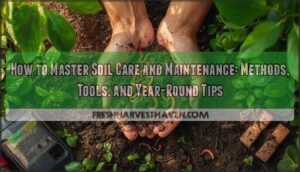This site is supported by our readers. We may earn a commission, at no cost to you, if you purchase through links.

Most gardeners lose half their harvest to poor timing. You plant tomatoes too early and frost kills them, or you miss the fall planting window entirely. The difference between abundance and disappointment often comes down to working with your climate instead of against it.
Garden planning by season turns this challenge into a simple rhythm you can follow year after year. When you map your tasks to hardiness zones and track local frost patterns, you stop guessing and start growing with confidence.
A solid seasonal plan transforms scattered efforts into a system that builds momentum from winter seed orders through fall’s final harvest, letting you anticipate what each month requires before it arrives.
Table Of Contents
Key Takeaways
- Seasonal garden planning transforms scattered guessing into a rhythm you can follow year-round by tracking your hardiness zone, frost dates, and microclimate quirks—cutting pest problems by 40-60% and boosting yields by up to 48% through smart crop rotation.
- Winter is your planning season: review last year’s notes to spot what worked, order seeds early for 15-30% savings, and prep tools now so spring doesn’t catch you scrambling with dull blades and empty seed packets.
- Spring timing hinges on your last frost date—start cool-season crops like lettuce and peas when soil hits 40°F, then wait for 60°F+ soil before planting warm-season tomatoes and peppers to avoid frost damage and maximize harvest windows.
- Summer maintenance keeps production rolling through deep watering once weekly (not daily sprinkling), mulching to cut water needs by 66%, and harvesting ripe crops daily so plants keep producing instead of shutting down mid-season.
Garden Planning Basics by Season
Before you can plant a single seed, you need to understand the ground rules that shape your growing season. Your garden’s success depends on knowing your hardiness zone, tracking frost dates, and building a year-round plan that works with your climate.
These three basics form the foundation for every decision you’ll make, from what to plant to when you’ll harvest.
Understanding USDA Hardiness Zones
You’ll want to start with the USDA Hardiness Zones—your garden’s foundation. These zones map out average winter lows across 13 regions, helping you choose plants that’ll survive your coldest nights.
Zone map updates in 2023 show many areas warming by half a zone, expanding your options. The USDA’s website offers an accessible version of the updated map.
Remember, microclimate effects near buildings or slopes can shift your planting hardiness slightly, so observe your specific site closely.
Creating a Master Garden Plan
A master garden plan ties your design vision to practical seasonal planning. Start with scaled garden plans on paper or use digital planning tools to map bed dimensions, crop rotation zones, and planting schedules.
Keep garden records of what thrived where—this guides smarter resource use next year. A well-designed plan can also increase property value.
Your garden layout becomes a working document you’ll improve through seasons, balancing beauty with productive garden design.
Importance of Frost Dates and Climate
Your layout is only as reliable as the climate data behind it. Frost dates have shifted about three days earlier in spring and later in fall since 1980, extending growing seasons across most regions. Microclimate impacts from elevation, water, and urban heat also create frost date variability within a single neighborhood—making local observations as important as USDA Hardiness Zones for climate adaptation and planting strategies.
- Track your specific frost dates over several seasons to spot regional variability patterns
- Watch for microclimate impacts like shade pockets or heat-trapping walls that alter frost timing
- Adjust planting zones mentally as climate zone gardening shifts northward with warming trends
- Use frost date trends to push seasonal gardening windows earlier in spring or later in fall
- Combine USDA data with hyperlocal weather patterns for smarter planting strategies year-round
Winter Garden Planning and Preparation
Winter is when your garden sleeps, but your planning should wake up. This quiet season gives you time to look back at what worked, stock up on supplies without the spring rush, and get your tools ready for action.
Let’s walk through three key tasks that will set you up for a smoother, more successful growing year ahead.
Reviewing Garden Notes and Crop Rotation
Reviewing last season’s notes isn’t just reflection—it’s your roadmap to better yields. Gardeners who maintain detailed records see yield optimization jump by 23%, while crop rotation cuts pest issues by 40-60% and boosts soil health through natural nitrogen enrichment. Track what worked, what didn’t, and plan your rotations now for sustainable yields that reduce costs and support smart garden planning and management.
Garden records turn reflection into results—track your wins, rotate your crops, and watch yields climb by 23% while pests drop by half
| Rotation Benefits | Soil Health Impact | Cost Reduction |
|---|---|---|
| 27-48% yield increase | +200 lbs/acre nitrogen | 8-15% savings |
| 40-60% fewer pests | Enhanced microbial life | 12% less fertilizer waste |
| 14-90% drought protection | +1.2% organic matter/year | Lower synthetic dependency |
Ordering Seeds and Supplies Cost-Effectively
During late winter, you’ll slash seed expenses by ordering early—up to 15% off through vendor price comparison and off-season purchases. Bulk seed benefits deliver 30-60% savings per packet, while coupon stacking strategies can exceed 30% discounts combined.
For DIY supplies, make compost from kitchen scraps, saving $150 annually. Smart seasonal planning and gardening resources transform winter into your most cost-effective garden planning window.
Maintaining and Organizing Garden Tools
Before spring arrives, you’ll extend tool longevity through smart maintenance and organization strategies. Cleaning frequency matters—weekly for daily-use tools, monthly otherwise. Tool storage off the ground prevents rust, while vertical racks boost capacity by 40%.
Try these gardening tips:
- Hang long-handled tools to protect edges
- Use pegboards with tool outlines for quick identification
- Mark grips with bright tape to reduce outdoor loss
Proper tool maintenance cuts wear by 30%.
Spring Planting Strategies and Tasks
Spring is when your winter planning pays off and the garden comes to life. You’ll move from sketches and seed orders to actual planting, timing everything around your last frost date.
This section walks you through starting seeds, choosing the right crops for each temperature window, prepping your beds, and building a planting calendar that keeps you on track.
Starting Seeds Indoors and Outdoors
You can jump-start your seasonal gardening calendar by sowing seeds indoors 6 to 8 weeks before frost—this indoor seed approach boosts germination success rates through controlled environmental factors like warmth and light.
It’s economical too: a $4 seed packet yields 15-plus plants versus buying mature transplants at garden stores.
Outdoor gardening works for hardy crops, but indoor vs outdoor timing shapes your comparative yield and harvest windows considerably.
Selecting Cool- and Warm-Season Crops
Your crop selection hinges on ideal temperatures and frost tolerance. Cool-season crops like lettuce, broccoli, and peas thrive in 65–80°F air with soil above 40°F, while warm-season crops such as tomatoes and peppers demand 70–95°F and soil exceeding 60°F.
Match your gardening calendar to these planting windows, then layer in crop rotation and succession planting to stretch harvests across your entire seasonal gardening cycle.
Preparing and Pruning Garden Beds
Before you drop a single seed, your garden beds need a solid foundation. Loosen soil 6–8 inches deep, then fold in 2–3 inches of compost to boost nutrients and drainage.
Prune in late winter to early spring—removing dead wood encourages vigorous growth while minimizing disease risk. Keep mulch one to two inches from plant crowns to prevent rot and maintain healthy root zones.
Creating a Seasonal Planting Calendar
A seasonal planting calendar transforms guesswork into gardening success. Frost date tracking anchors your schedule, while crop maturity dates keep harvests rolling through succession planting.
- Map regional variations and microclimate adjustments for your zone
- Mark seed-starting windows 5–8 weeks before transplant dates
- Build in flexibility for unexpected weather shifts
Your gardening calendar becomes the blueprint that turns seasonal gardening planning into consistent yields.
Summer Maintenance and Fall Transitions
Summer is when your garden hits its stride, but it’s also when things can spiral out of control without a steady hand. You’ll need to stay on top of watering, pest control, and harvest timing to keep plants producing through the heat.
At the same time, late summer is your window to set up fall crops and prepare perennials for the cooler months ahead.
Deep Watering and Mulching Techniques
During summer’s heat, your plants need water that reaches down eight to twelve inches—deep enough to encourage strong roots. A single deep watering each week beats daily sprinkling. Pair this with two to three inches of mulch, and you’ll cut watering needs by up to 66% while keeping soil moisture stable for days longer.
| Mulch Material | Water Retention | Nutrient Cycling |
|---|---|---|
| Wood Chips | Holds moisture 3–5 days longer | Slow nitrogen release |
| Straw | Reduces evaporation 70% | Fast decomposition |
| Rice Husks | Excellent coverage | Moderate enrichment |
| Polythene | Highest retention | No organic benefit |
Choose organic mulches for soil health. As they break down, they feed your plants phosphorus and potassium while building humus. This creates a garden that practically waters itself, saving you time and money all season long.
Pest Inspection and Flower Deadheading
While you’re tending beds, check both leaf surfaces twice weekly for aphids, beetles, and caterpillars. Regular pest inspection catches trouble early, cutting crop damage by 60%. Deadheading flowers every one to two weeks keeps blooms coming while removing pest hiding spots where thrips and aphids gather. This integrated approach prevents disease, attracts pollinators, and maintains garden health without heavy pesticide use—smart seasonal gardening that saves time.
- Pinch spent blooms on petunias and geraniums
- Cut back larger flower stems on roses
- Remove yellowing leaves harboring insects
Harvesting Ripe Crops for Continuous Yield
Pick vegetables when they’re ripe—tomatoes, beans, and peppers keep producing when you harvest daily. This harvesting technique encourages continuous crop yields throughout summer.
Stagger planting schedules every two weeks for lettuce and radishes so you’re never overwhelmed or empty-handed.
Your crop management improves when you balance soil management with smart crop selection, keeping beds fed with compost while rotating what you grow.
Planting and Preparing for Fall Crops
As summer winds down, prepare your fall garden by timing plantings carefully. Cool-season crops like kale and lettuce need six to eight weeks before frost, so count backward from your first expected freeze date.
Your fall crop selection sets up a productive harvest through autumn.
- Choose crops suited to cooler weather—spinach, radishes, broccoli, and carrots thrive
- Mix amendments thoroughly with native soil to avoid drainage problems
- Apply 2–4 inches of organic mulch to retain moisture
- Rotate plant families to reduce disease by up to 60%
- Water deeply twice weekly for consistent moisture management
Top 3 Products for Seasonal Garden Planning
Planning a garden year-round takes more than just seeds and soil. The right tools and resources help you track what works, preserve your harvest, and make smarter decisions each season.
Here are three products that support your garden planning from winter prep through fall cleanup.
1. Maple Syrup Tree Tapping Kit
Making your own syrup connects you to the land in ways typical garden planning can’t match. This maple syrup tapping kit includes 10 sustainable tree taps, 10 food-grade drop lines, and a reusable filter—everything you need to harvest sap during tapping season.
The kit components support multiple seasons of use, making the cost analysis favorable for small-scale projects. Average syrup yield runs about 0.34 gallons per tap.
It’s a seasonal gardening technique that teaches patience and timing, core gardening tips for any thoughtful garden planning approach with minimal environmental impact.
Best For: Families or hobbyists who want a hands-on way to make their own maple syrup at home and don’t mind the time investment of collecting and boiling sap.
- Includes everything to get started—10 taps, drop lines, and a reusable filter that work season after season
- Made with food-grade materials that are easy to clean and safe for syrup production
- Fun educational project that connects you to seasonal rhythms and teaches patience
- The 24-inch tubes might be too short depending on your setup, possibly requiring extra tubing
- Sap flow depends entirely on weather, so yields can be unpredictable from day to day
- You’ll still need a separate boiler or large pot to cook down the sap, which takes hours of careful heat management
2. Ball Complete Book of Home Preserving
Your harvest doesn’t end at the garden gate. The Ball Complete Book of Home Preserving offers 400 recipes and expert canning safety protocols, guiding you through food preservation with the confidence of 1.5 million readers who trust it.
Edition updates reflect preserving trends like low-sugar options and fermentation, while user reviews praise its seasonal gardening alignment.
Recipe innovation meets practical crop management, transforming your summer bounty into year-round nourishment. It’s the bridge between harvesting and savoring what you’ve grown.
Best For: Home gardeners and preserving enthusiasts who want to turn fresh produce into safe, long-lasting pantry staples with tested recipes and modern techniques.
- 400 tested recipes covering everything from classic jams to trendy fermented foods, with options for low-sugar and contemporary health preferences
- Clear safety guidelines and troubleshooting help that make canning less intimidating for beginners while offering advanced techniques for experienced canners
- Proven track record with 1.5 million copies sold and regular updates that keep the content current with the latest food safety research
- Some users find important safety information tucked in the back rather than up front, making the organization less intuitive
- Not all recipes include every fruit or ingredient you might expect, so you may need to adapt or supplement with other sources
- Canning requires precision with timing and altitude adjustments, so it’s not a casual weekend project—you need to follow instructions carefully
3. Preserving Everything Your Guide to Food
Beyond canning techniques and pickling recipes, Leda Meredith’s Preserving Everything covers freezing methods, fermentation benefits, and dehydration tips across 13 preservation approaches. At $18.96, this Countryman Know How guide connects harvesting techniques directly to food preservation and storage strategies.
You’ll find practical crop management and harvesting wisdom for fruits, vegetables, meat, and dairy. While some readers note occasional recipe gaps, beginners appreciate its encouraging approach to food preservation.
The troubleshooting section helps you master seasonal abundance, turning your garden’s yield into a well-stocked pantry that lasts through winter.
Best For: Home cooks and gardeners who want to preserve their seasonal harvest using multiple methods—from canning and freezing to fermenting and dehydrating—without needing prior experience.
- Covers 13 different preservation techniques in one book, so you’re not locked into just canning or pickling
- Beginner-friendly approach with troubleshooting help when things go wrong
- Goes beyond recipes to explain the actual principles behind preservation, which helps you experiment confidently
- Some recipes have gaps or editing issues that might leave you guessing on key details
- Doesn’t dive deep into specialized topics like salt curing or long-term meat storage
- Missing specific storage timeframes for some preserved foods, which can be frustrating when planning pantry rotation
Frequently Asked Questions (FAQs)
How do I transition plants between indoor and outdoor?
Start by hardening off seedlings gradually over 10 to 14 days, increasing outdoor exposure daily. Monitor temperature closely, protect from wind, and adjust watering needs as plants acclimate to new light conditions.
What are companion planting strategies for each season?
Companion planting can transform your garden into a pest-fighting powerhouse. Winter companions like beets with leafy greens, spring pairings of basil with tomatoes, summer synergies of corn-beans-squash, and fall combinations of brassicas with onions improve seasonal gardening naturally.
When should I prune different types of fruit trees?
Prune apples and pears in late winter before buds break.
Peaches need early spring attention to avoid cold damage.
Citrus trees respond best to February through April pruning, reducing disease risk while promoting healthy growth and seasonal planning success.
How do rainfall patterns affect my watering schedule?
Rainfall patterns shift your watering frequency dramatically. During wet months, you’ll water less to prevent waterlogging. In dry stretches, irrigation needs increase.
Smart controllers automatically adjust schedules based on local precipitation, optimizing soil moisture year-round.
What are the best natural fertilizers by season?
Think of soil as a bank account: compost enriches winter soil preparation, bone meal powers spring boosters for roots, fish emulsion delivers summer nutrients quickly, and fall amendments rebuild reserves with manure and cover crops for seasonal gardening success.
Conclusion
Without garden planning by season, you’re basically guessing your way through twelve months and hoping nature cooperates. With it, you’ve built a framework that anticipates frost, maximizes every planting window, and keeps your beds productive when neighbors’ gardens sit empty.
The rhythm becomes second nature—winter prep flows into spring action, summer maintenance feeds fall abundance. You’re not just reacting to weather anymore. You’re orchestrating a year-round system that consistently delivers the harvest you’ve been chasing.
- https://www.daintydressdiaries.com/2023/07/seasonal-gardening-calendar-what-to-plant-and-do-each-month.html
- https://tylerarboretum.org/how-to-plan-your-garden-for-a-year-of-success/
- https://civicscience.com/more-than-2-in-5-have-lawn-and-garden-projects-planned-this-summer-balancing-budgets-and-sustainability/
- https://www.growveg.com/garden-planner-calendar.aspx
- https://www.homedepot.com/c/ai/10-fall-gardening-trends/9ba683603be9fa5395fab901da361cab










